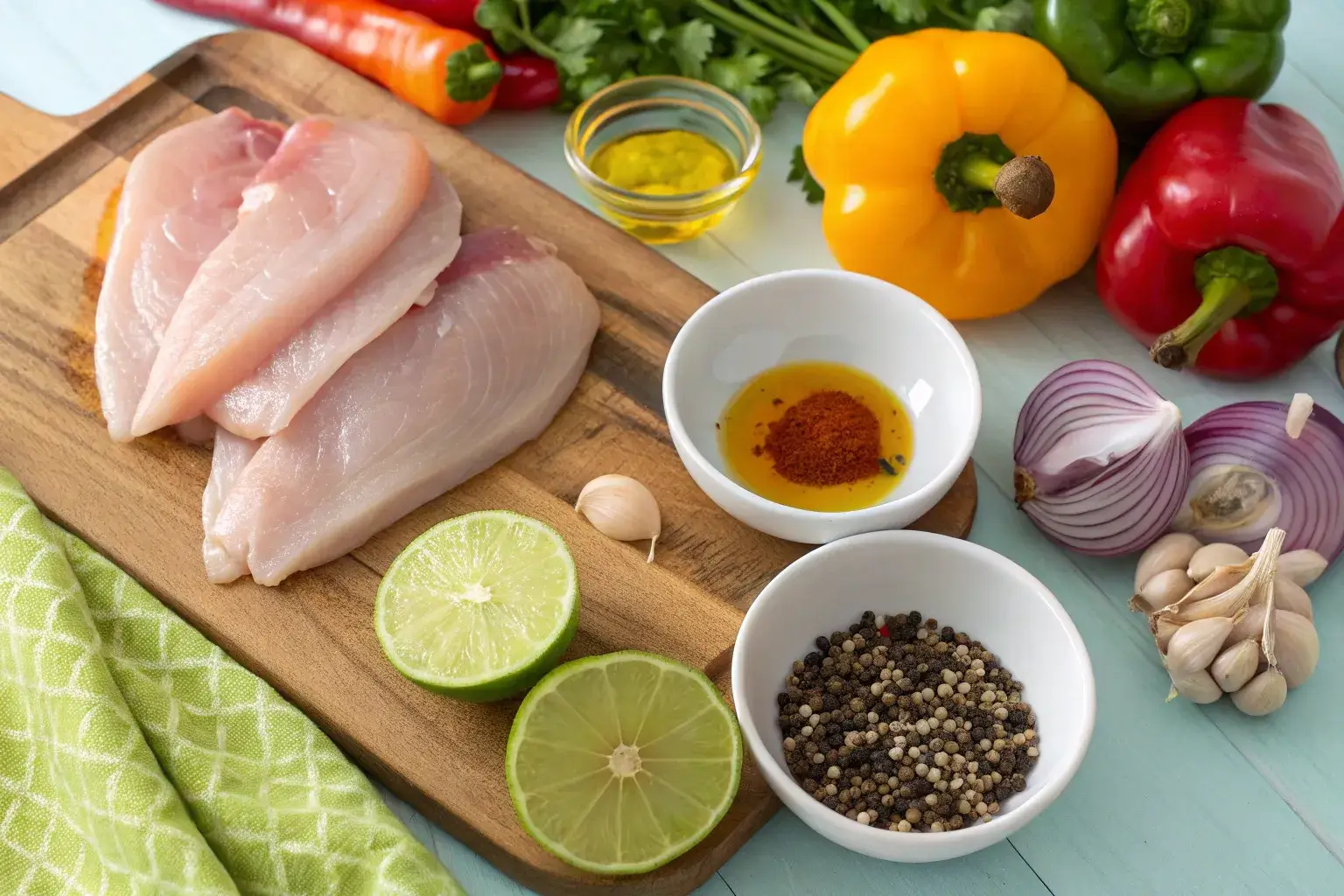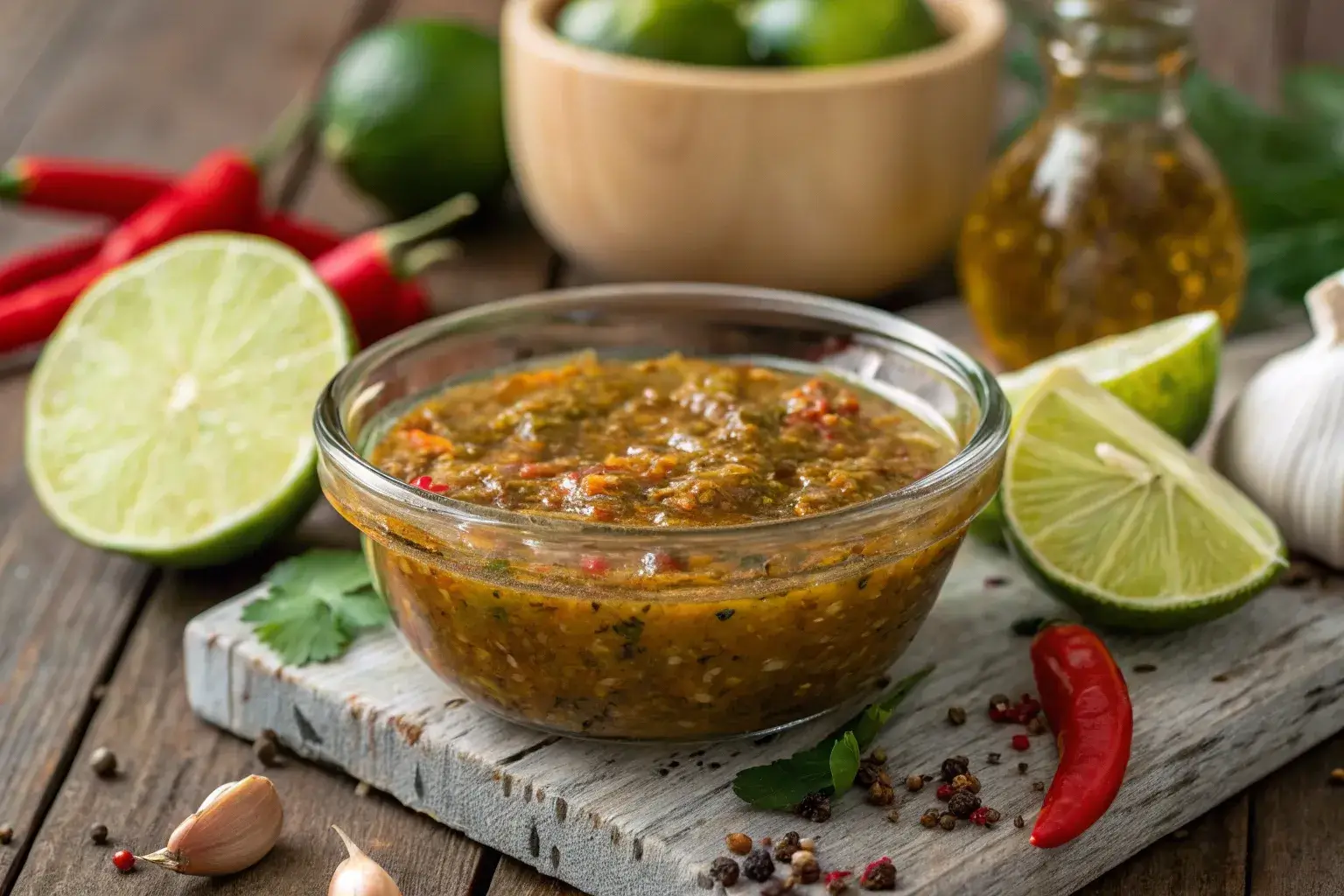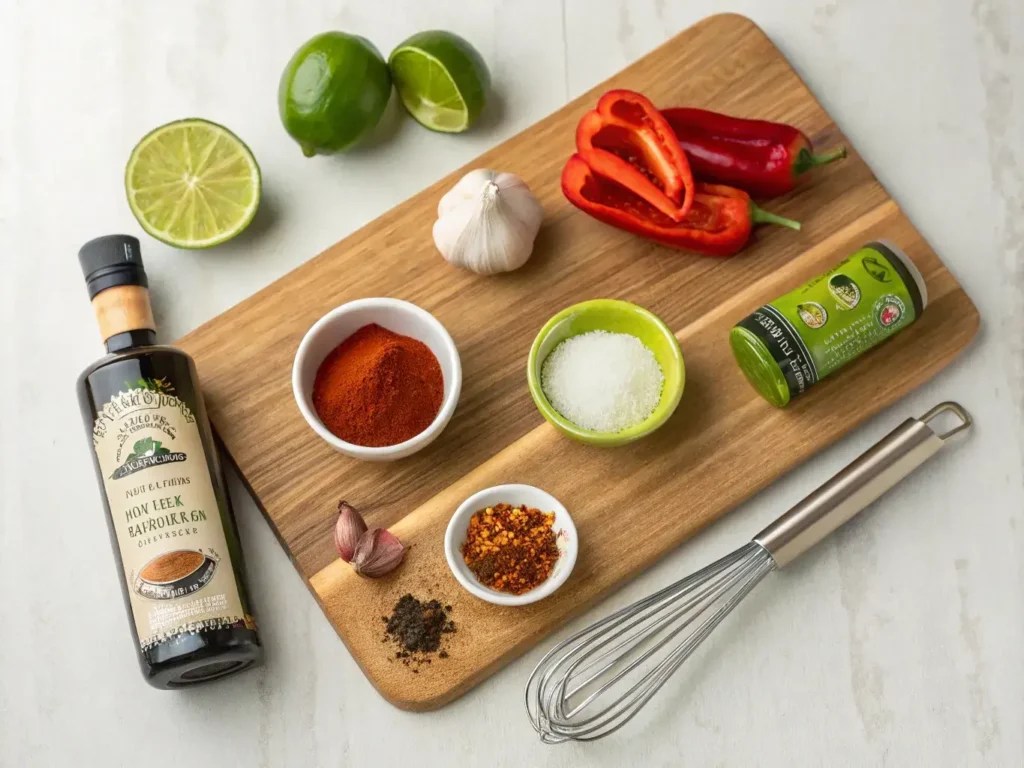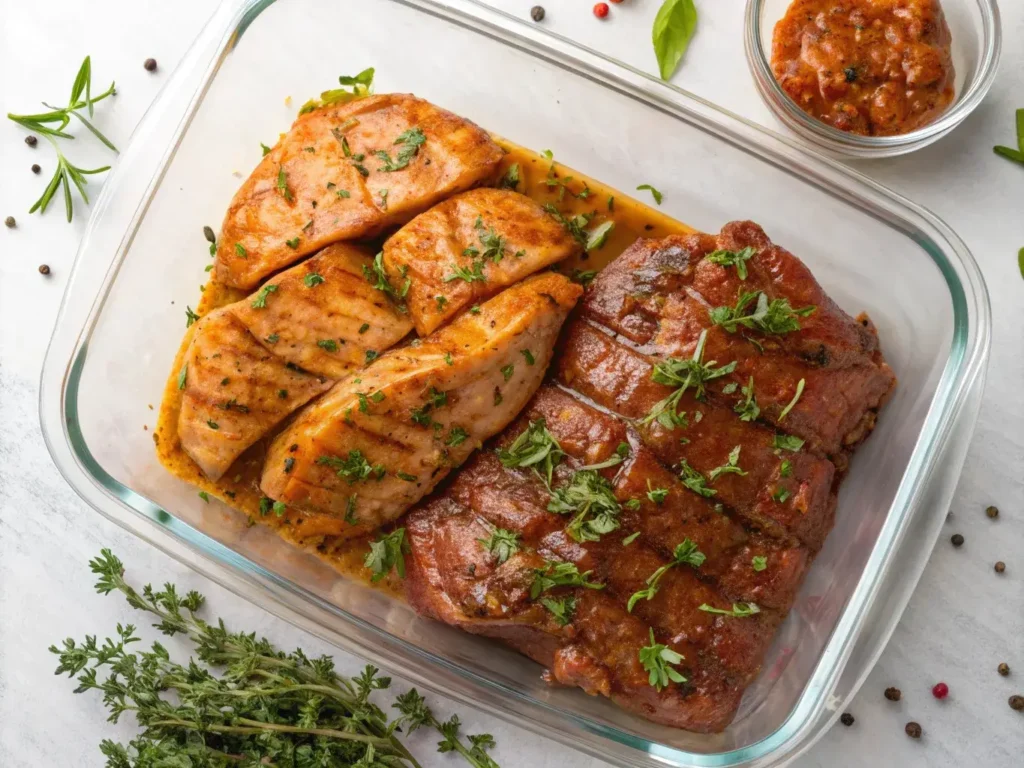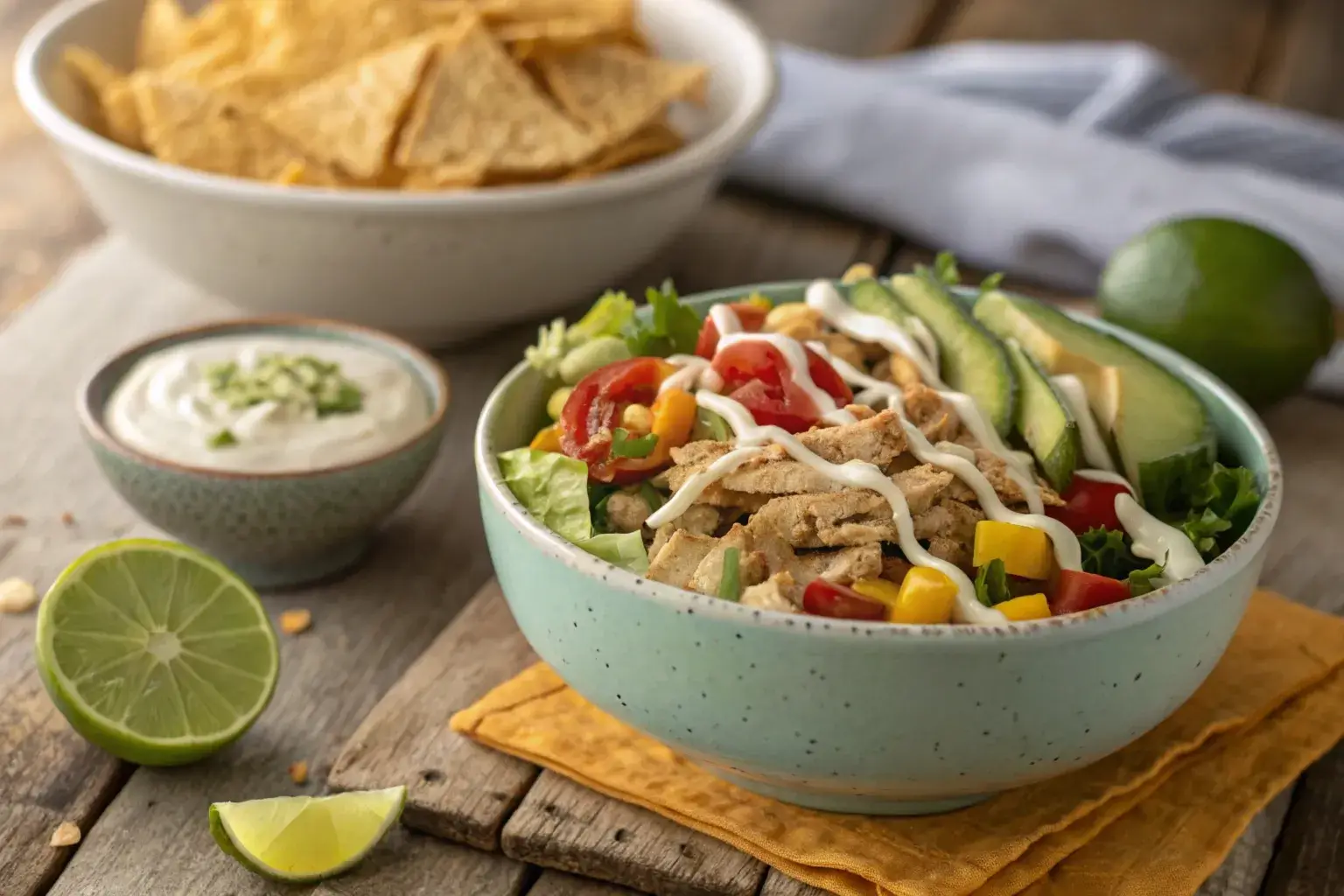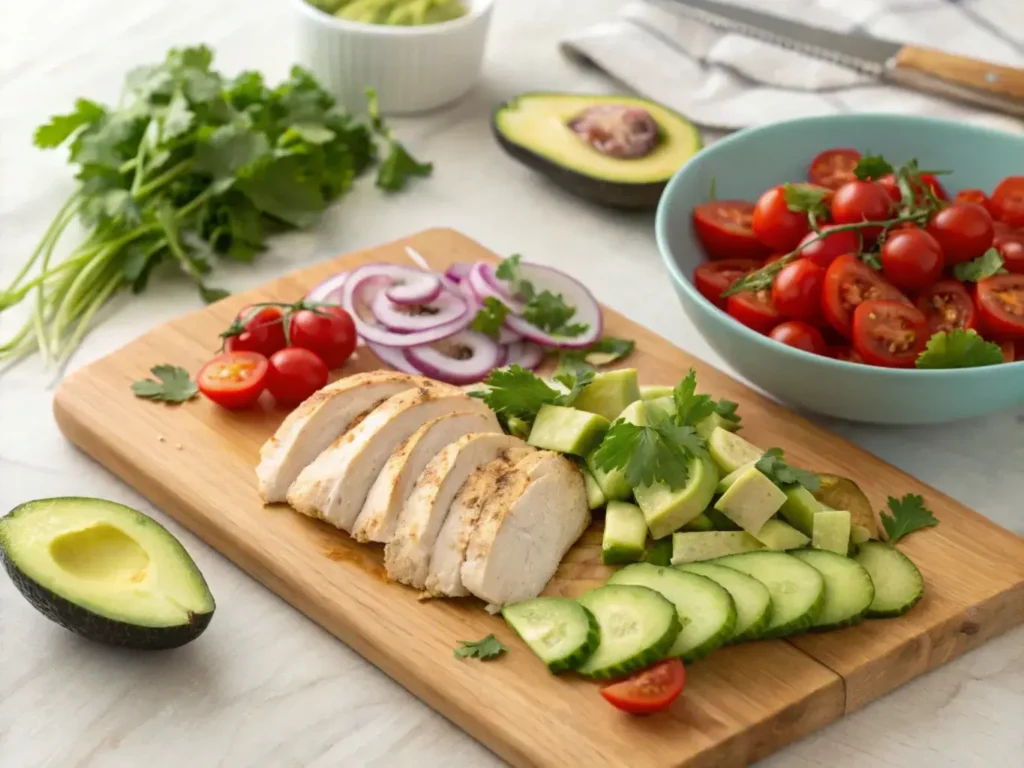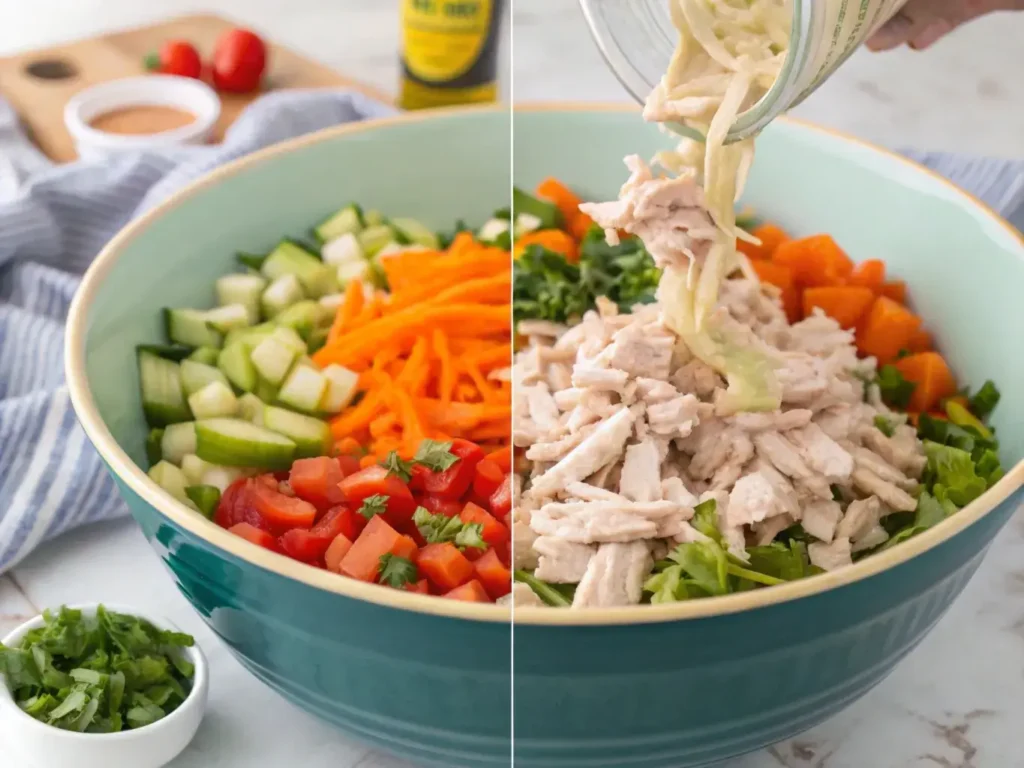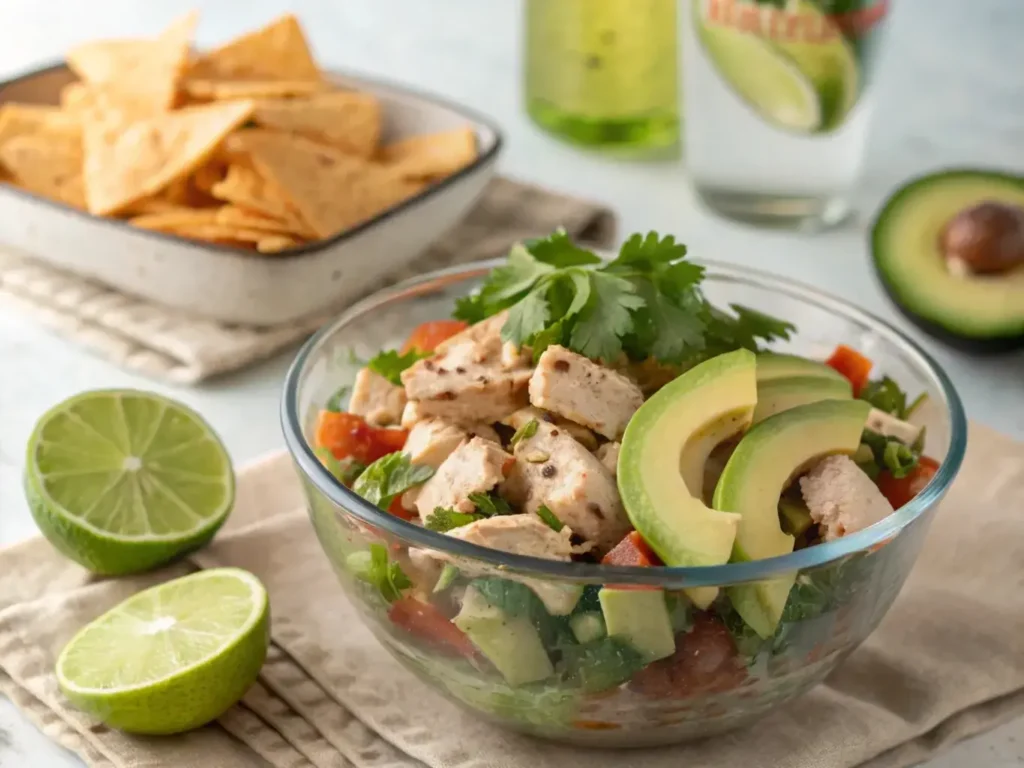Let’s be real fajitas are all about that first bite, right? The juicy chicken, the smoky spices, the zesty lime… it’s pure bliss. But what’s the secret behind it all? It’s the chicken fajita marinade! Yep, that humble mixture is the unsung hero, transforming plain chicken into a mouthwatering masterpiece. The best part? Making it at home is super easy and totally worth it. Whether you love bold heat, a touch of sweetness, or something in between, you can tweak this marinade to match your cravings. So, roll up your sleeves, grab your spices, and let’s create a fajita experience you won’t forget. Trust me, it’s gonna be epic!
Why Your Fajitas Deserve the Perfect Chicken Fajita Marinade
What Makes a Marinade Essential?
A good chicken fajita marinade isn’t just an extra step it’s the foundation of bold, mouthwatering flavor. Marinades serve a dual purpose: they tenderize the chicken while infusing it with a blend of spices, acidity, and richness. For fajitas, the marinade plays a crucial role in balancing the smoky heat of spices like paprika and chili powder with the tang of lime juice. Without this step, the chicken can feel dry and bland, leaving your fajitas lackluster.
Moreover, marinades allow the flavors to penetrate deep into the chicken, creating a harmony that’s hard to achieve otherwise. For instance, the oil in the marinade helps carry fat-soluble flavors, while the acid breaks down the meat’s proteins, ensuring tenderness. In short, skipping the marinade would mean missing out on the very heart of what makes fajitas so irresistible.
The Benefits of a Homemade Chicken Fajita Marinade
Let’s talk options. Sure, you could grab a premade marinade from the store, but is it worth it? Homemade chicken fajita marinades offer something store-bought versions simply can’t match: control. By making your marinade at home, you can adjust the salt, tweak the spice level, and avoid artificial preservatives or excessive sugar.
Store-bought marinades may save a few minutes, but they often come with drawbacks like overpowering flavors or hidden additives. Homemade versions, on the other hand, let you use fresh ingredients like minced garlic, freshly squeezed lime juice, and fragrant spices to create a marinade tailored to your preferences. Plus, they’re often more affordable and versatile. For more on why homemade recipes are superior, check out this guide to creating your own marinades.
Choosing the Right Chicken for Fajitas
Believe it or not, the type of chicken you use makes a big difference. Chicken breasts and chicken thighs are the two most common choices, but they perform differently when paired with a chicken fajita marinade.
Chicken thighs are known for their rich flavor and higher fat content, which makes them naturally juicy and harder to overcook. They’re perfect for grilling or searing since they can handle high heat without drying out. On the other hand, chicken breasts are leaner and cook faster, making them a convenient option. However, they’re more prone to drying out, so marinating them thoroughly is key to keeping them moist and flavorful.
For fajitas, both cuts work well, but thighs often win for their tenderness and rich taste. Whichever you choose, ensure the pieces are sliced evenly so they cook consistently.
The Science of Marinating Chicken
Marinating chicken might seem simple, but there’s a bit of science behind the magic. A chicken fajita marinade combines three essential components: fat, acid, and flavorings. Each plays a specific role in transforming the chicken into a tender, flavor-packed delight.
- Fat: Ingredients like olive oil help carry the flavors of spices and herbs into the chicken. It also creates a barrier that keeps the meat juicy during cooking.
- Acid: Lime juice or vinegar breaks down muscle proteins in the chicken, which makes it more tender. However, too much acid can overdo it, leaving the chicken mushy—so stick to the recommended marination times.
- Flavorings: Spices like cumin, paprika, and chili powder, combined with aromatics like garlic and onion, create the bold flavors you associate with fajitas. These ingredients cling to the chicken and caramelize beautifully during cooking.
Understanding these elements ensures you’re not just marinating but mastering the art of fajita-making. With this knowledge, your fajitas are bound to be a hit!
How to Make the Ultimate Chicken Fajita Marinade
Essential Ingredients for a Flavor-Packed Marinade
The key to a great chicken fajita marinade lies in its ingredients. Each component serves a unique purpose, working together to deliver bold flavors and tenderize the chicken. Here’s what you’ll need:
- Citrus juice (lime or lemon): Adds brightness and tenderizes the meat.
- Oil (olive or avocado): Helps the flavors stick to the chicken and keeps it juicy.
- Spices (paprika, cumin, chili powder): Create that classic smoky, spicy flavor.
- Garlic and onion: Enhance the depth and savory notes.
- Sweeteners (honey or brown sugar): Balance the tang and spice with a hint of sweetness.
You can also include optional ingredients like soy sauce for umami or jalapeños for extra heat. Feel free to experiment, but remember, balance is the key to a successful marinade.
Step-by-Step Recipe for Chicken Fajita Marinade
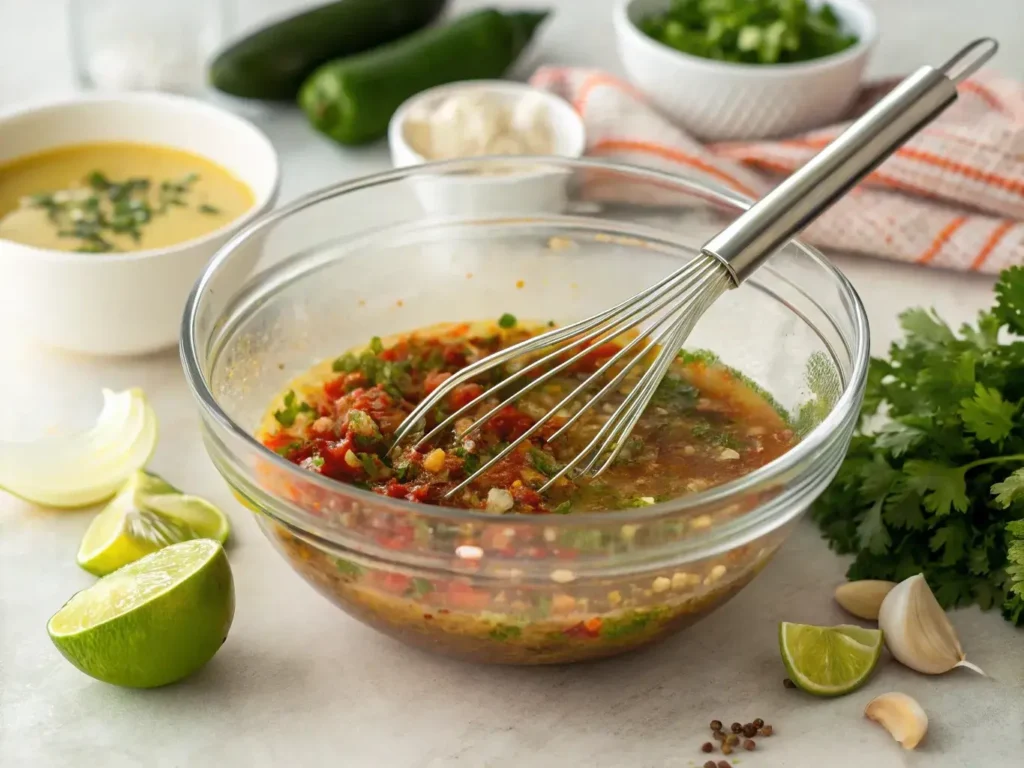
Crafting the perfect chicken fajita marinade is simple and only takes a few minutes:
- Combine the ingredients: Mix lime juice, olive oil, minced garlic, and your spices in a bowl.
- Taste and adjust: Always taste your marinade before applying it. Add a pinch of salt or a touch more lime juice as needed.
- Marinate the chicken: Place the chicken in a resealable bag or container, pour the marinade over it, and seal it tightly.
- Let it rest: Refrigerate for at least 2 hours, but no more than 6 hours to avoid a mushy texture.
With this easy recipe, your chicken will soak up all the zesty, smoky flavors, ensuring your fajitas are anything but boring. For a detailed marinade recipe, check out this guide.
Tips for Proper Marination
To get the most out of your chicken fajita marinade, follow these expert tips:
- Don’t skimp on marination time: Allow the chicken to marinate for at least 2 hours so the flavors can penetrate the meat.
- Use a resealable plastic bag: This ensures the marinade evenly coats all sides of the chicken.
- Refrigerate immediately: Always keep marinating chicken in the fridge to prevent bacteria growth.
- Avoid over-marinating: While it’s tempting to let it sit overnight, acids in the marinade can break down the meat too much, resulting in an unappealing texture.
By keeping these tips in mind, you’ll achieve tender, flavorful chicken every time.
Cooking Techniques for Fajitas
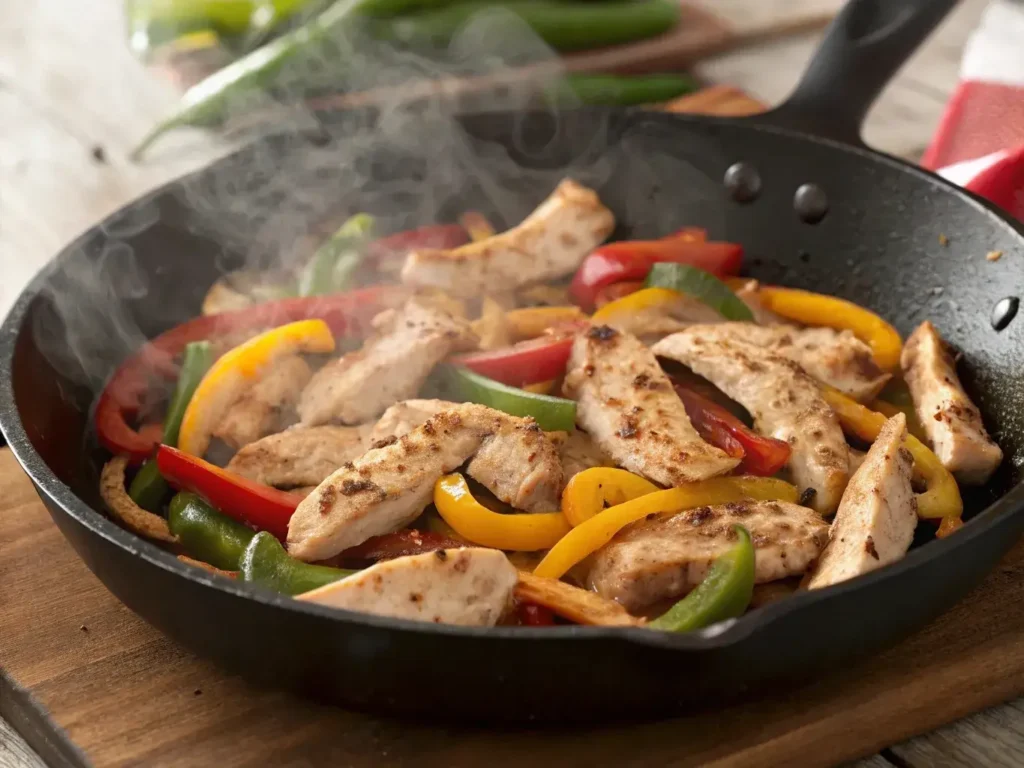
Now that your chicken fajita marinade has done its magic, it’s time to cook! Here are three popular methods to bring your fajitas to life:
- Grilling: Preheat your grill to medium-high heat. Cook the chicken for 6-8 minutes per side or until it reaches an internal temperature of 165°F (75°C). Grilling adds a smoky char that complements the marinade beautifully.
- Pan-searing: Heat a cast-iron skillet over medium-high heat. Sear the marinated chicken for about 4-6 minutes per side. This method is perfect for getting a nice caramelized crust.
- Baking: If grilling or searing isn’t an option, bake the marinated chicken in a preheated oven at 400°F (200°C) for 20-25 minutes.
Each method has its perks, but grilling often delivers the best flavor. Pair your cooked chicken with sautéed bell peppers and onions for a classic fajita experience.
Secrets to Juicy and Flavorful Chicken Fajitas
Balancing Acidity, Spice, and Sweetness
The key to a well-rounded chicken fajita marinade lies in its balance of flavors. A good marinade isn’t just spicy or tangy it’s a harmonious blend of acidity, spice, and a touch of sweetness. For instance, lime juice adds the zesty kick that’s essential in fajitas, but pairing it with a sweetener like honey or brown sugar ensures the acidity doesn’t overpower the dish.
Spices like cumin, smoked paprika, and chili powder create depth, while garlic and onion bring in savory undertones. Adjusting these ingredients to your taste is simple: if you prefer a bolder kick, add a pinch of cayenne; if you like a milder profile, dial back the chili powder and let the natural sweetness of the honey shine. By tweaking these elements, you can create a marinade that perfectly suits your palate.
The Importance of Cooking Temperatures
Cooking chicken to the right temperature is crucial for retaining its juiciness, especially when using a chicken fajita marinade. Undercooked chicken can be unsafe, while overcooked chicken tends to be dry and chewy.
To achieve the best results, aim for an internal temperature of 165°F (75°C) at the thickest part of the chicken. Using a meat thermometer removes the guesswork. On the grill, medium-high heat is ideal, as it helps achieve that signature char while keeping the meat tender. In a skillet, ensure the pan is hot enough to sear the chicken without burning the marinade.
Keeping a close eye on the cooking process ensures your chicken stays moist and flavorful, with the marinade’s spices caramelizing beautifully during cooking.
Resting and Slicing the Chicken
Once your marinated chicken is cooked to perfection, resist the urge to slice it immediately. Resting the chicken for about 5-10 minutes allows the juices to redistribute, ensuring every bite is tender and juicy. This small step can make a big difference in the final texture of your fajitas.
When it’s time to slice, use a sharp knife and cut the chicken against the grain. This technique shortens the muscle fibers, making each piece more tender and easier to chew. For fajitas, aim for thin, uniform strips that pair well with sautéed vegetables and tortillas. Proper slicing ensures the chicken fajita marinade flavor is present in every bite.
Pairing Marinade with Fajita Toppings and Sides
The chicken fajita marinade is only part of the equation—pairing it with the right toppings and sides takes your meal to the next level. For toppings, consider guacamole, sour cream, shredded cheese, or a squeeze of fresh lime. Each adds a unique flavor or texture that complements the marinated chicken.
As for sides, classics like Mexican rice, refried beans, or even a simple green salad work wonderfully. If you’re feeling adventurous, grilled corn or a creamy avocado salad can add a fresh twist. For more inspiration, check out our guide to grilled chicken thigh recipes, which includes creative ideas for side dishes.
Variations of Chicken Fajita Marinade to Try
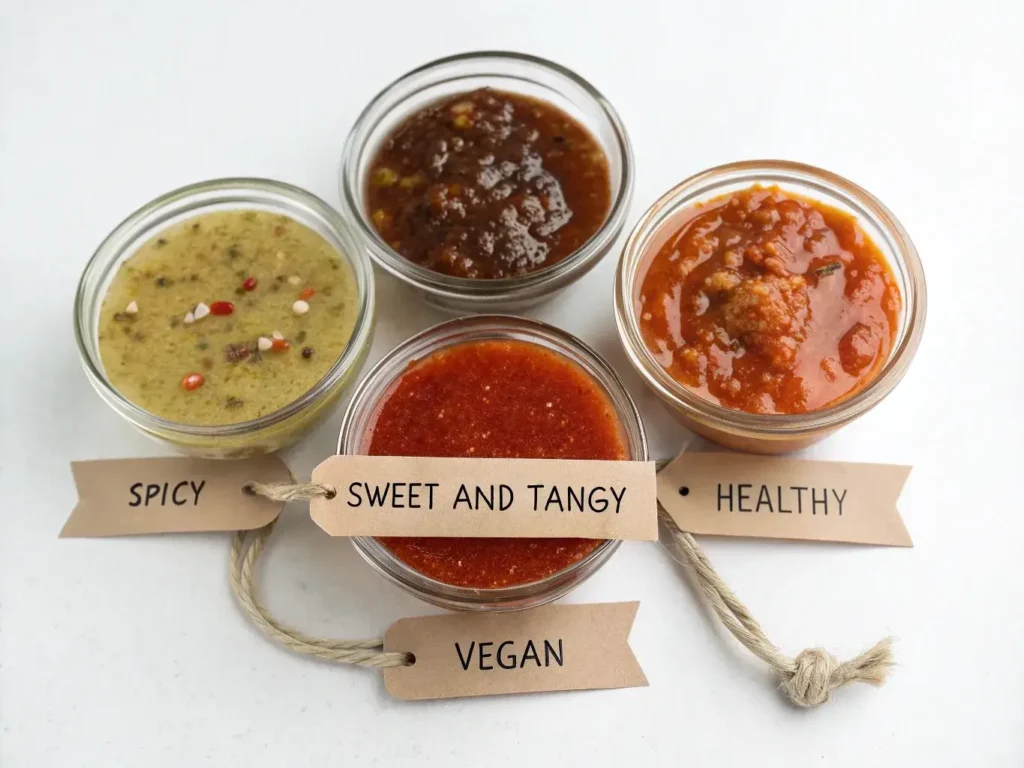
Spicy Fajita Marinade
For those who love a fiery kick, a spicy chicken fajita marinade is the way to go. Adding ingredients like chipotle peppers in adobo sauce, fresh jalapeños, or cayenne pepper can turn up the heat without overpowering the other flavors.
For example, you can blend a tablespoon of chipotle sauce with lime juice, olive oil, and garlic to create a smoky, spicy base. To balance the heat, consider adding a touch of honey or brown sugar. This combination ensures that your fajitas pack a punch while remaining well-rounded.
Adjust the spice level according to your preference by experimenting with different chili varieties. Remember, the marinade should complement the other elements of your fajitas, like sautéed vegetables and creamy toppings, rather than dominate them.
Sweet and Tangy Fajita Marinade
If you prefer a more balanced flavor profile, try a sweet and tangy chicken fajita marinade. Ingredients like honey, orange juice, or even pineapple juice can add a delightful sweetness that pairs beautifully with the tang of lime and the warmth of fajita spices.
For instance, combine orange juice with garlic, cumin, and smoked paprika to create a marinade that’s bursting with citrusy goodness. The natural sugars in the juice will caramelize during cooking, giving the chicken a slightly crispy, golden finish.
This variation is especially popular for grilled fajitas, as the sweet elements enhance the smoky charred flavor of the chicken. Serve with fresh salsa or guacamole to complement the tangy notes.
Healthy and Low-Calorie Marinade Options
Looking for a lighter option? A healthy chicken fajita marinade can be just as flavorful without unnecessary calories. Swap traditional oils for low-fat yogurt or use a small amount of avocado oil, which is packed with healthy fats.
For a simple low-calorie marinade, mix Greek yogurt, lime juice, garlic, and a pinch of chili powder. The yogurt not only tenderizes the chicken but also gives it a creamy texture. Additionally, using fresh herbs like cilantro or parsley can enhance the flavor without adding extra calories.
By choosing lighter ingredients, you can enjoy all the bold flavors of fajitas without compromising on your health goals. Pair this version with whole-grain tortillas and a side of roasted vegetables for a guilt-free meal.
Vegan and Vegetarian Marinade Options
A chicken fajita marinade can easily be adapted for vegan or vegetarian fajitas. By using the same flavorful base and substituting chicken with tofu, portobello mushrooms, or even jackfruit, you can create a plant-based version that’s just as satisfying.
For tofu, press it to remove excess moisture, then marinate it in a blend of lime juice, olive oil, smoked paprika, and garlic. For mushrooms, their meaty texture works beautifully with a marinade that includes balsamic vinegar and chili powder.
When cooking vegan fajitas, the marinade is especially important, as it infuses the plant-based ingredients with the smoky, zesty flavors you’d expect in classic fajitas. These options are perfect for anyone looking to explore meat-free alternatives without sacrificing taste.
Common Mistakes to Avoid When Making Chicken Fajita Marinade
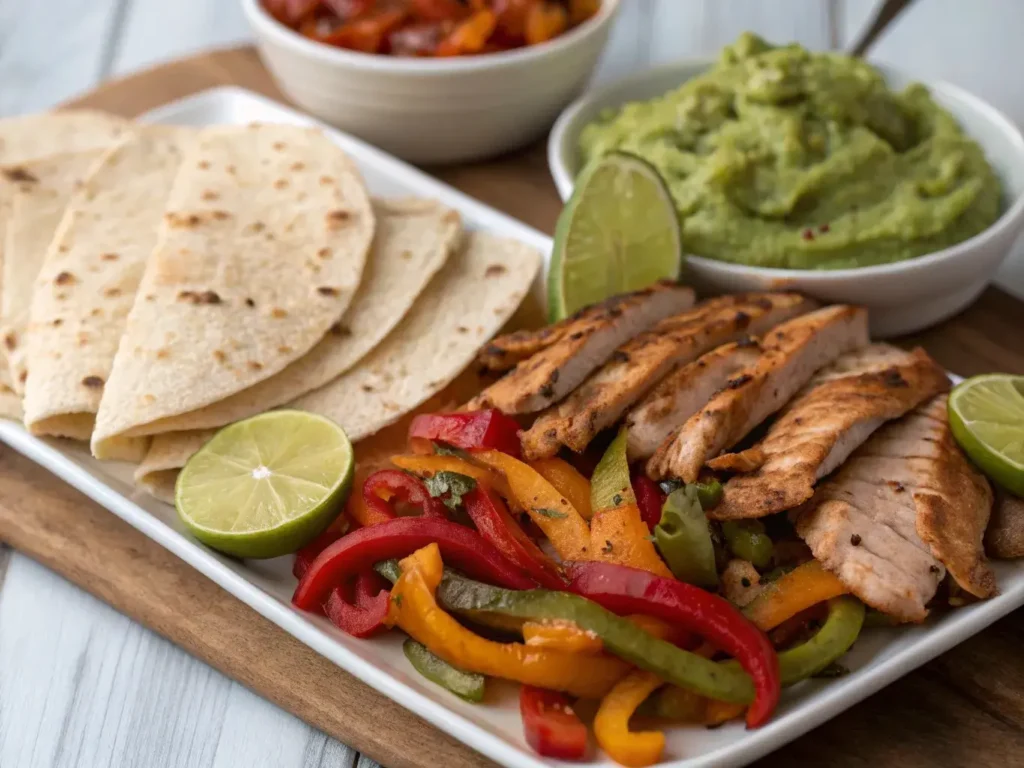
Over-Marinating Chicken
While it might seem like leaving chicken in a marinade for hours is a good idea, overdoing it can actually ruin the texture. Acidic ingredients, such as lime juice or vinegar, are essential in a chicken fajita marinade, but they can break down the proteins in chicken too much if left for too long. This results in a mushy or stringy texture that’s far from ideal.
To avoid this mistake, stick to a marination window of 2-6 hours. For a quick fix, even 30 minutes of marination can work wonders. On the other hand, anything over 12 hours is usually too much and can lead to disappointing results. Timing is everything when it comes to achieving that perfect balance of flavor and tenderness.
Skipping Proper Cooking Techniques
Even the best chicken fajita marinade won’t save you if the chicken isn’t cooked properly. One common mistake is using a skillet or grill that’s not hot enough, which prevents the chicken from developing that beautiful seared crust. Alternatively, cooking at too high a heat can cause the marinade to burn before the chicken is fully cooked.
For optimal results, preheat your skillet or grill to medium-high heat. This ensures even cooking while allowing the marinade’s sugars and spices to caramelize. Using a cast-iron skillet can enhance the smoky flavors, while grilling imparts a delicious char that complements the marinade perfectly.
Forgetting to Taste and Adjust
A great chicken fajita marinade starts with a great balance of flavors, but what works on paper may not always work on your palate. Forgetting to taste and adjust the marinade before applying it is a missed opportunity to refine the final dish.
Always take a small spoonful of your marinade to ensure it’s balanced. Too tangy? Add a splash of oil or a pinch of sugar. Not bold enough? Increase the spices slightly. By tasting and adjusting as needed, you’ll ensure the flavors are exactly how you want them before they hit the chicken.
Not Resting Chicken After Cooking
Resting the chicken after cooking is a simple step that many overlook, but it’s vital for retaining juiciness. When chicken is cooked, its juices are concentrated in the center. Slicing it immediately lets those juices escape, leaving the meat dry.
To avoid this, let the chicken rest for 5-10 minutes after it’s taken off the heat. During this time, the juices redistribute throughout the meat, ensuring every bite is moist and flavorful. Whether you’re grilling, baking, or pan-searing, this final step can make all the difference in your fajitas.
FAQs
Can you marinate fajitas too long?
Yes, you can marinate fajitas too long, especially when using a chicken fajita marinade with acidic ingredients like lime juice or vinegar. These acids are essential for tenderizing the chicken, but over-marination (more than 12 hours) can break down the meat’s proteins excessively, leading to a mushy texture.
To avoid this, aim for a marination time between 2-6 hours. If you’re short on time, even 30 minutes can impart great flavor. However, sticking to the optimal marination window ensures tender, flavorful chicken without compromising its texture.
How long do you grill chicken fillet
When grilling chicken fillets marinated in a chicken fajita marinade, the cooking time depends on the thickness of the fillets. Generally, grill the chicken over medium-high heat for about 6-8 minutes per side, or until the internal temperature reaches 165°F (75°C).
Using a meat thermometer ensures accuracy and prevents overcooking. Additionally, the sugars and spices in the marinade can caramelize beautifully on the grill, so keeping a close eye on the chicken will help avoid burning.
Where are chicken fajitas from?
Chicken fajitas have their roots in Tex-Mex cuisine, a fusion of Texas and Mexican culinary traditions. The term “fajita” originates from the Spanish word faja, meaning “strip” or “belt,” referring to the sliced meat traditionally used in the dish.
Originally made with skirt steak, fajitas became popular in the 20th century and evolved to include chicken, vegetables, and a variety of toppings. Today, they’re a global favorite known for their bold, smoky flavors and sizzling presentation.
What is the formula for chicken marinade?
A classic formula for a flavorful chicken fajita marinade includes three essential components:
- Fat: Usually olive oil, which carries the flavors and keeps the chicken moist.
- Acid: Lime juice, vinegar, or other citrus juices to tenderize the chicken.
- Flavorings: A mix of spices (like cumin, chili powder, and paprika), garlic, and sometimes sweeteners like honey or brown sugar.
A typical ratio is 3 parts oil to 1 part acid, plus seasonings to taste. This balance ensures your marinade is both effective and delicious.
Conclusion
Creating the perfect chicken fajita marinade is simpler than you might think, yet it holds the power to elevate your fajitas from good to truly unforgettable. By understanding the balance of flavors: acid, fat, and seasonings you can craft a marinade that ensures tender, juicy chicken packed with bold, zesty flavors.
From mastering marination times to choosing the right cooking method, each step contributes to making your fajitas a crowd-pleasing success. Whether you prefer a spicy kick, a sweet and tangy twist, or even a low-calorie option, there’s a marinade variation to suit your taste. And by avoiding common mistakes, like over-marinating or skipping proper cooking techniques, you’ll guarantee flavorful results every time.

